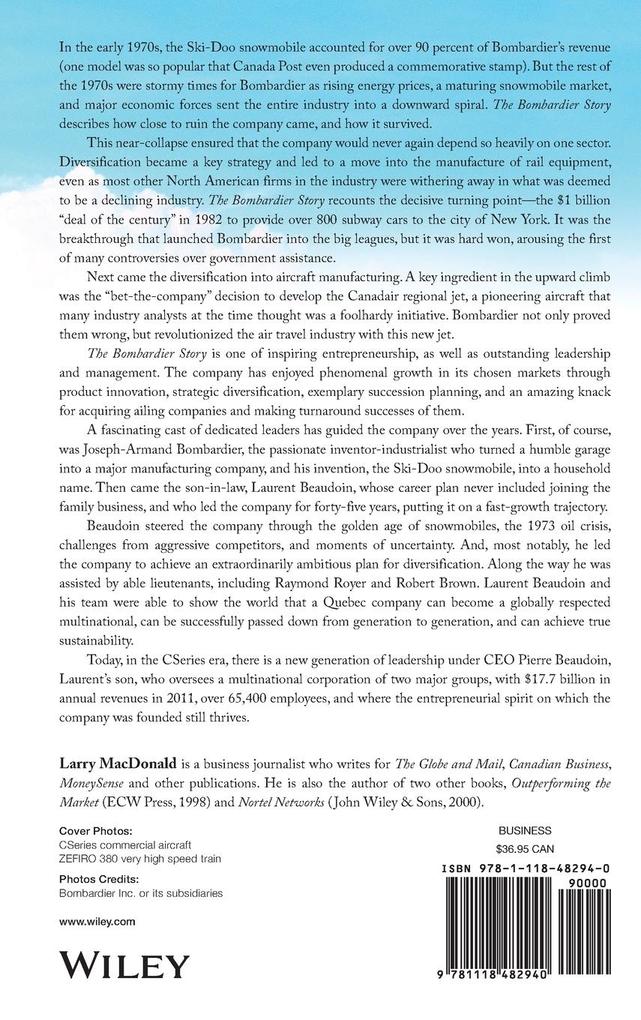In the early 1970s, the Ski-Doo snowmobile accounted for over 90 percent of Bombardier's revenue (one model was so popular that Canada Post even produced a commemorative stamp). But the rest of the 1970s were stormy times for Bombardier as rising energy prices, a maturing snowmobile market, and major economic forces sent the entire industry into a downward spiral. The Bombardier Story describes how close to ruin the company came, and how it survived. This near-collapse ensured that the company would never again depend so heavily on one sector. Diversification became a key strategy and led to a move into the manufacture of rail equipment, even as most other North American firms in the industry were withering away in what was deemed to be a declining industry. The Bombardier Story recounts the decisive turning point--the $1 billion "deal of the century" in 1982 to provide over 800 subway cars to the city of New York. It was the breakthrough that launched Bombardier into the big leagues, but it was hard won, arousing the first of many controversies over government assistance. Next came the diversification into aircraft manufacturing. A key ingredient in the upward climb was the "bet-the-company" decision to develop the Canadair regional jet, a pioneering aircraft that many industry analysts at the time thought was a foolhardy initiative. Bombardier not only proved them wrong, but revolutionized the air travel industry with this new jet. The Bombardier Story is one of inspiring entrepreneurship, as well as outstanding leadership and management. The company has enjoyed phenomenal growth in its chosen markets through product innovation, strategic diversification, exemplary succession planning, and an amazing knack for acquiring ailing companies and making turnaround successes of them. A fascinating cast of dedicated leaders has guided the company over the years. First, of course, was Joseph-Armand Bombardier, the passionate inventor-industrialist who turned a humble garage into a major manufacturing company, and his invention, the Ski-Doo snowmobile, into a household name. Then came the son-in-law, Laurent Beaudoin, whose career plan never included joining the family business, and who led the company for forty-five years, putting it on a fast-growth trajectory. Beaudoin steered the company through the golden age of snowmobiles, the 1973 oil crisis, challenges from aggressive competitors, and moments of uncertainty. And, most notably, he led the company to achieve an extraordinarily ambitious plan for diversification. Along the way he was assisted by able lieutenants, including Raymond Royer and Robert Brown. Laurent Beaudoin and his team were able to show the world that a Quebec company can become a globally respected multinational, can be successfully passed down from generation to generation, and can achieve true sustainability. Today, in the CSeries era, there is a new generation of leadership under CEO Pierre Beaudoin, Laurent's son, who oversees a multinational corporation of two major groups, with $17.7 billion in annual revenues in 2011, over 65,400 employees, and where the entrepreneurial spirit on which the company was founded still thrives.
Inhaltsverzeichnis
Acknowledgments ix
A Brief History of Bombardier Inc. xi
Preface xix
Introduction: The Rise of a Corporation 1
A Meteoric Rise 1
The Architects of Success 6
Bombardier Today 8
Part One 13
Chapter 1: Joseph-Armand Starts a Company: The 1940s and 1950s 15
Humble Beginnings 15
The Bombardier Snowmobile 16
Inventions and Innovations 25
Chapter 2: The Ski-Doo Adventure: The Golden Age of the 1960s 34
The Family Takes Over 34
A Marketing Renewal 39
Ski-Doo Fever 42
Vertical Integration 46
The First Sea-Doo 49
Part Two 53
Chapter 3: Diversify or Die: The 1970s 55
A Challenging Decade 55
Taking a New Turn: Rail Transportation 59
The Montreal Subway 61
The Acquisition of MLW-Worthington 67
Chapter 4: The Deal of the Century: The New York City Subway (1982) 73
A Golden Opportunity 73
A Contested Victory 78
The Tools for Success 84
The Royer Way of Doing Things 86
The BMS 91
A Major Breakthrough 97
Tempest in a Teapot 101
The Value of Proven Technologies 104
A Welcome Boost 107
Chapter 5: New Frontiers: Transportation in the 1980s and 1990s 110
The North American Market 110
Full Speed Ahead 112
A Rocky Start for the LRC 114
The Vagaries of High-Speed in America 117
The Disney Monorail 124
The Acquisition of UTDC 125
Capturing the European Market 129
The Chunnel Odyssey 133
Taking Over by Storm: From Talbot to Adtranz 137
Part Three 143
Chapter 6: Aerospace Takes Off 145
A Bold Move 145
Early Attempts to Diversify: The Automotive Sector 149
The Acquisition of Canadair (1986) 151
Good Things Come in Threes: Shorts, Learjet, and de Havilland 156
Portrait of a Turnaround Artist 165
Power in Numbers: Synergizing Operations 171
Chapter 7: Revolution in the Sky: The Move Toward Regional Jets 176
The Rise of Airline Hubs 176
From Challenger to CRJ 179
A New Captain Steers Aerospace Group 186
Bombardier Takes Off 192
Dogfight in the Clouds 196
Inside the Pro-ex Saga 201
An Affair of State 205
Government Support 208
Chapter 8: Spreading Its Wings 216
The Global Express Business Jet (1991-1996) 216
Diversification Delivers 225
Part Four 229
Chapter 9: Two Turbulent Decades at Valcourt 231
The Ski-Doo Loses Speed 231
Pierre Beaudoin and the Return of the Sea-Doo (1988) 233
Extreme Snowmobiling and Innovation 238
Acquisition of Outboard Marine Corporation (2001) 241
Chapter 10: Lessons in Strategic Governance 244
The É minence Grise 244
Decentralization 248
Management Tools 253
An Evolving Structure 256
Chapter 11: Handing Over the Reins 259
Robert Brown Takes Charge 259
The Impact of September 2001 264
Tellier Joins Bombardier 265
An Unexpected Comeback 270
Pierre Takes the Helm and CSeries Aircraft Takes Off 273
Laurent Beaudoin's Legacy 276
Endnotes 279
Index 293














